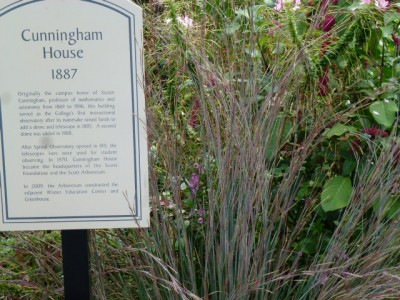Plants of the Week: September 26
 Schizachyrium scoparium ‘Standing Ovation’
Schizachyrium scoparium ‘Standing Ovation’
Surprise! Another grass! And, hopefully, like the others I showcased, Schizachyrium scoparium ‘Standing Ovation’ will have you on your feet and clapping your hands.
A perennial ornamental bunchgrass, Schizachyrium scoparium ‘Standing Ovation’ likes full sun, well-drained soil, and average amounts of water. It will grow to about 4 feet high, and about 1.5 feet wide.
A native to American Midwestern prairies, Schizachyrium scoparium produces modest, though fuzzy, beige spikes of flowers during late summer and early fall. However, the main selling point of ‘Standing Ovation’ is its beautiful, blue-green and purple-red coloration that looks like a living fireworks display exploding from the ground.
Schizachyrium scoparium ‘Standing Ovation’ only needs is to be cut to the ground at the beginning of spring to allow for new growth. It can self-seed, but does not do so prolifically. It is drought and deer-resistant. Our Schizachyrium scoparium ‘Standing Ovation’ can be found throughout the Scott Entrance Garden. I certainly give this plant a ‘Standing Ovation’ and hopefully you will too! Photo credit: D. Alvarez
Heptacodium miconioides
A multi-stemmed, deciduous, large shrub/small tree, Heptacodium miconioides is probably one of the first plants you will notice on your way up College Avenue to the Wister Center from the 320 intersection.
Also called the seven-son flower, Heptacodium miconioides does indeed produce simple, but sweet-scented white flowers that form clusters of seven. This China native attracts birds and butterflies. Because it is threatened in the wild, growing it from seed or softwood cuttings has helped secure its existence throughout the West as an ornamental plant and thus in turn preserve this piece of biodiversity.
Heptacodium miconioides requires average amounts of water, prefers full sun, and well-drained soil, but can tolerate shade and other soil types. It can grow up to 25 feet tall and out to 12 feet wide. Even after the white flowers and red pods of autumn have passed, the tan bark exfoliates to reveal a richer, dark-brown bark. If you want to add a rare, fall/winter interest small tree to your shade garden and a focal point, Heptacodium miconioides is a good choice. Photo credit: J. Coceano
Amaranthus sp.
A gem of the Cut Flower Garden, Amaranthus has a tall, striking stalk with dark, purple-red stems, foliage, and cymes of fluffy flowers. The soft, rich, colorful flowers of Amaranthus bloom from midsummer until first frost. However, the seed will ripen several weeks before, allowing you to harvest it by rubbing the drying seed heads.
Aside from planting more Amaranthus, the seeds can be toasted like popcorn and eaten or ground into coarse flour for baking bread and pastries. Toasted Amaranthus seeds can also be used “as-is” to make snacks.
Native to Mexico, the Aztecs made statue-cakes with honey and Amaranthus of the hummingbird god, Huitzilopochtli, coincidentally, around Christmas-time. At the end of the festival on December 26th, the statue-cake would be sliced up and a piece given to everyone to eat in order to consume a part of their god.
Amarantus likes full sun, warmth, and dry well-drained soil. The spread is not really an issue since it likes to grow in clumps, but can tower over other plants at 8 feet tall. For a plant that is pretty and practical, try Amaranthus. Photo credit: J. Coceano






No Comments